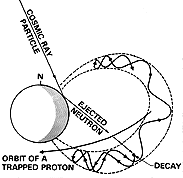|
The inner radiation belt, discovered by Explorers 1 and 3, owes its existence to the extraordinary stability of trapped orbits near the Earth. It is a by-product of the cosmic radiation, which by itself has a rather low intensity: the amount of energy received by Earth from cosmic rays is comparable to what it receives from starlight. Only by accumulating particles over the span of years does the inner belt reach its high intensity.
Cosmic rays are fast positive ions, bombarding Earth from all directions, probably filling our entire galaxy. Though their numbers are small, the energy of each particle is quite high, so that when these ions smash into nuclei of atmospheric gases, fragments go flying off in different directions, some of them short-lived particles created by the collision. Most such fragments are absorbed by the atmosphere or by the ground, but a few are also splattered upwards, out of the atmosphere and into space.
If these are electrically charged, e.g. electrons or ions, they will often end up trapped by the Earth's magnetic field. None of these however lasts very long, since trapped orbits which rise from the atmosphere must sooner or later enter the atmosphere again.
|

 Official GSFC Home Page
Official GSFC Home Page  NASA WWW Home Page
NASA WWW Home Page